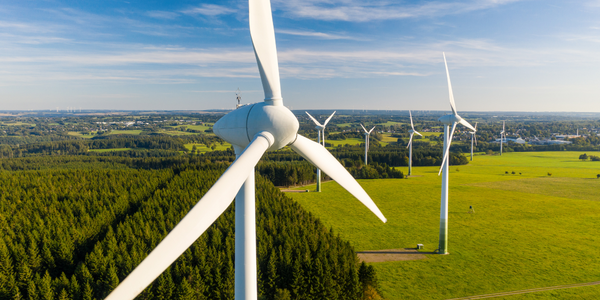下载PDF
Smart Monitoring Solutions for Solar Panels: A Case Study

技术
- 基础设施即服务 (IaaS) - 私有云
- 网络与连接 - WiFi
适用行业
- 电网
- 可再生能源
用例
- 行为与情绪追踪
- 泄漏与洪水监测
服务
- 云规划/设计/实施服务
- 系统集成
挑战
对于这个项目,NWC 与一家为住宅、商业和工业客户生产和销售电力的客户合作。在 700 x 700 米的场地中监测 88,000 块发电能力为 28 兆瓦/小时的太阳能电池板所产生的电量的要求对客户提出了挑战。最初的想法是一个 13 公里的有线光网络;超过 10 亿日元的成本将这种方法定义为昂贵且不切实际。因此,客户需要一个无线网关解决方案来在站点和监控中心之间进行通信。
该项目的重点是设计满足以下条件的太阳能监控系统:
- 成本效益
- 耐用性
- 无线通信
- 灵活的数据采集(IO 和 PLC)
客户
网络公司
关于客户
NWC 专门为建筑提供自动化解决方案。
服务:(楼宇管理系统)iNBIS全系列功能一站式提供,提供理想系统。从顶层 PC 到底层无线传感器,所有设备都具有内置通信功能和 CPU。应用提前准备,即插即用构建一站式综合管理系统,设备间通信设置自动配置。
解决方案
ADAM-3600 被选中用于监控太阳能电池板产生的电力,因为它符合客户的标准。 ADAM-3600 从太阳能电池板收集发电数据,并使用 LTE 通信将收集到的数据发送到云端。 18 个带有三个可编程逻辑控制器的 ADAM-3600 单元连接所有太阳能电池板。
ADAM-3600 智能远程终端单元经久耐用,可承受 -40°C 至 70°C 的温度。此外,监控系统支持LTE和WiFi等无线通信。稳定、私有、安全且具有成本效益的无线网络能够实现可访问的通信,以便从太阳能电池板收集和收集数据。远程管理系统还允许从众多 IO 和 PLC 收集数据,有助于集成系统。实时监控提供实时信息,在出现任何异常时提醒团队。
运营影响
数量效益
相关案例.

Case Study
Remote Monitoring & Predictive Maintenance App for a Solar Energy System
The maintenance & tracking of various modules was an overhead for the customer due to the huge labor costs involved. Being an advanced solar solutions provider, they wanted to ensure early detection of issues and provide the best-in-class customer experience. Hence they wanted to automate the whole process.

Case Study
Vestas: Turning Climate into Capital with Big Data
Making wind a reliable source of energy depends greatly on the placement of the wind turbines used to produce electricity. Turbulence is a significant factor as it strains turbine components, making them more likely to fail. Vestas wanted to pinpoint the optimal location for wind turbines to maximize power generation and reduce energy costs.

Case Study
Siemens Wind Power
Wind provides clean, renewable energy. The core concept is simple: wind turbines spin blades to generate power. However, today's systems are anything but simple. Modern wind turbines have blades that sweep a 120 meter circle, cost more than 1 million dollars and generate multiple megawatts of power. Each turbine may include up to 1,000 sensors and actuators – integrating strain gages, bearing monitors and power conditioning technology. The turbine can control blade speed and power generation by altering the blade pitch and power extraction. Controlling the turbine is a sophisticated job requiring many cooperating processors closing high-speed loops and implementing intelligent monitoring and optimization algorithms. But the real challenge is integrating these turbines so that they work together. A wind farm may include hundreds of turbines. They are often installed in difficult-to-access locations at sea. The farm must implement a fundamentally and truly distributed control system. Like all power systems, the goal of the farm is to match generation to load. A farm with hundreds of turbines must optimize that load by balancing the loading and generation across a wide geography. Wind, of course, is dynamic. Almost every picture of a wind farm shows a calm sea and a setting sun. But things get challenging when a storm goes through the wind farm. In a storm, the control system must decide how to take energy out of gusts to generate constant power. It must intelligently balance load across many turbines. And a critical consideration is the loading and potential damage to a half-billion-dollar installed asset. This is no environment for a slow or undependable control system. Reliability and performance are crucial.

Case Study
Remote Monitoring and Control for a Windmill Generator
As concerns over global warming continue to grow, green technologies are becoming increasingly popular. Wind turbine companies provide an excellent alternative to burning fossil fuels by harnessing kinetic energy from the wind and converting it into electricity. A typical wind farm may include over 80 wind turbines so efficient and reliable networks to manage and control these installations are imperative. Each wind turbine includes a generator and a variety of serial components such as a water cooler, high voltage transformer, ultrasonic wind sensors, yaw gear, blade bearing, pitch cylinder, and hub controller. All of these components are controlled by a PLC and communicate with the ground host. Due to the total integration of these devices into an Ethernet network, one of our customers in the wind turbine industry needed a serial-to-Ethernet solution that can operate reliably for years without interruption.

Case Study
Temperature monitoring for vaccine fridges
Dulas wanted a way to improve the reliability of the cold chain, facilitating maintenance and ensuring fewer vaccines are spoiled. Dulas wanted an M2M solution which would enable them to record and report the temperature inside vaccine refrigerators.

Case Study
Hydro One Leads the Way In Smart Meter Development
In 2010, Ontario’s energy board mandated that time-of-use (TOU) pricing for consumers be available for all consumers on a regulated price plan. To meet this requirement, Hydro One needed to quickly deploy a smart meter and intelligent communications network solution to meet the provincial government’s requirement at a low cost. The network needed to cover Hydro One’s expansive service territory, which has a land mass twice the size of Texas, and its customers live in a mix of urban, rural, and remote areas, some places only accessible by air, rail, boat or snowmobile. Most importantly, the network needed to enable future enterprise-wide business efficiencies, modernization of distribution infrastructure and enhanced customer service. To meet these needs, Hydro One conceptualized an end-to-end solution leveraging open standards and Internet Protocols (IP) at all communication levels. The utility drew upon industry leaders like Trilliant to realize this vision.





